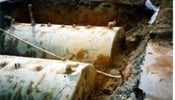

SCS Engineers was retained to investigate and remediate petroleum contaminated soils and groundwater impacted by multiple leaking underground storage tanks (USTs) at two former gas stations. Both facilities formerly functioned as retail service stations, dispensing gasoline and diesel fuel. The properties currently operate as automobile maintenance shops.
SCS’s services included:
 note taking; and report preparation. Thirty-three confirmatory soil samples were collected and analyzed.
note taking; and report preparation. Thirty-three confirmatory soil samples were collected and analyzed.